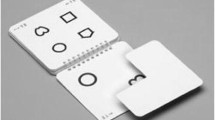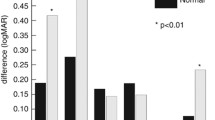Abstract
Purpose
To compare optotypes of the Amsterdam Picture Chart (APK) with those of Landolt-C (LC), Tumbling-E (TE), ETDRS and LEA symbols (LEA), to assess their reliability in measuring visual acuity (VA).
Methods
We recruited healthy controls with equal VA and amblyopes with ≥2 LogMAR lines interocular difference. New logarithmic charts were developed with LC, TE, ETDRS, LEA, and APK with identical size and spacing (four optotypes) between optotypes. Charts were randomly presented at 5 m under DIN EN ISO 8596 and 8597 conditions. VA was measured with LC (LC-VA), TE, ETDRS, LEA, and APK, using six out of ten optotypes answered correctly as threshold.
Results
In 100 controls aged 17–31, LC-VA was −0.207 ± SD 0.089 LogMAR. Visual acuity measured with TE differed from LC-VA by 0.021 (positive value meaning less recognizable), with ETDRS 0.012, with Lea 0.054, and with APK 0.117. In 46 amblyopic eyes with LC-VA <0.5 LogMAR, the difference was for TE 0.017, for ETDRS 0.017, for LEA 0.089, and for APK 0.213. In 13 amblyopic eyes with LC-VA ≥0.5 LogMAR, the difference was for TE 0.122, ETDRS 0.047, LEA 0.057, and APK 0.019. APK optotypes had a lower percentage of passed subjects at each LogMAR line compared to Landolt-C. The 11 APK optotypes had different thresholds.
Conclusions
Small APK optotypes were recognized worse than all other optotypes, probably because of their thinner lines. Large APK optotypes were recognized relatively well, possibly reflecting recognition acuity. Differences between the thresholds of the 11 APK optotypes reduced its sensitivity further.







Similar content being viewed by others
References
Gutter M, Limpens D, Moed JL, de Graaf MEL (1999) Handleiding praktische vaardigheden orthoptie, 2nd edn. Luiten, Barendrecht, pp 199–201
Van Velzen-Mol HWM, Blankespoor MN, Wagenaar-Fischer MM, van Leerdam FJM (2003) De standaard ‘Opsporing visuele stoornissen 0–19 jaar‘ van de jeugdgezondheidszorg. Neth J Med 147:2012–2017
Hyvärinen L, Näsänen R, Laurinen P (1980) New visual acuity test for preschool children. Acta Ophthalmol 58:507–511
Gräf MH, Becker R (1999) Determining visual acuity with LH symbols and Landolt rings. Klin Monatsbl Augenheilkd 215(2):86–90
Gräf MH, Becker R, Kaufmann H (2000) LEA symbols: visual acuity assessment and detection of amblyopia. Arch Ophthalmol 238:53–58
Rassow B, Wang Y (1999) Correlation of letter optotypes with Landholt ring for different degrees of visual acuity. Klin Monatsbl Augenheilkd 215:119–126
Becker B, Hübsch S, Gräf MH, Kaufmann H (2002) Examination of young children with LEA symbols. Br J Ophthalmol 86(5):513–516
Becker R, Teichler G, Gräf M (2011) Comparison of visual acuity measured using Landolt-C and ETDRS charts in healthy subjects and patients with various eye diseases. Klin Monatsbl Augenheilkd 228(10):864–867
Lai YH, Wang HZ, Hsu HT (2011) Development of visual acuity in preschool children as measured with Landolt C and Tumbling E charts. J AAPOS 15:251–255
Wesemann W, Schiefer U, Bach M (2010) Neue DIN-Normen zur Sehschärfebestimmung. Ophthalmologe 107:821–826
Wittich W, Overbury O, Kapusta MA, Watanabe DH (2006) Difference between recognition and resolution acuity in patients undergoing macular hole surgery. Invest Ophthalmol Vis Sci 47:3690–3694
Candy TR, Mishoulam SR, Nosofsky RM, Dobson V (2011) Adult discrimination performance for pediatric acuity test optotypes. Invest Ophthalmol Vis Sci 52(7):4307–4313
Conflict of Interest
None
Author information
Authors and Affiliations
Corresponding author
Rights and permissions
About this article
Cite this article
Engin, Ö., Despriet, D.D.G., van der Meulen-Schot, H.M. et al. Comparison of optotypes of Amsterdam Picture Chart with those of Tumbling-E, LEA Symbols, ETDRS, and Landolt-C in non-amblyopic and amblyopic patients. Graefes Arch Clin Exp Ophthalmol 252, 2013–2020 (2014). https://doi.org/10.1007/s00417-014-2763-7
Received:
Revised:
Accepted:
Published:
Issue Date:
DOI: https://doi.org/10.1007/s00417-014-2763-7




